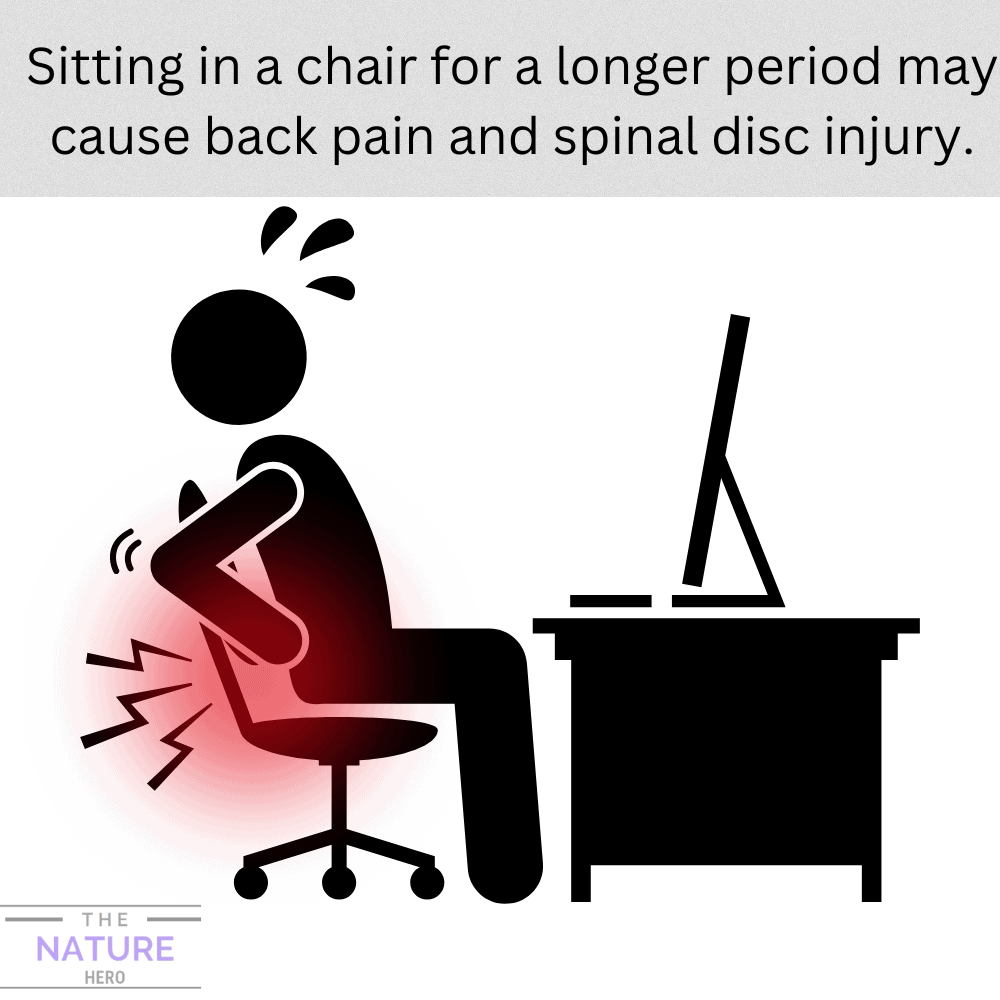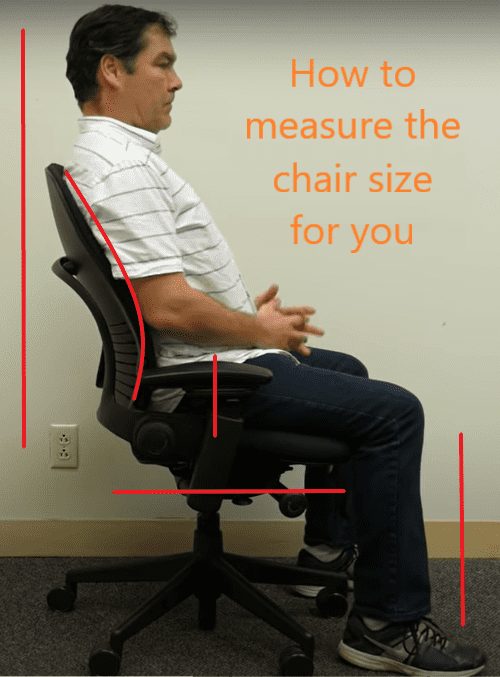The correct Office Chair size plays a vital role because inappropriate Chairs often compromise your body posture, health, and productivity.
Remember, Office Chairs are never one-size-fits-all; hence standard-sized Chairs may not be appropriate if you are taller or shorter.
Find out about different Office Chair sizes and how to measure one to suit your height and body weight.
Table of Contents Show
Importance of Right-Sized Office Chair
According to research, people spend about 7,709 days of their lives sitting!
If you consider that, a person spends an average of 30% of their lifetime sitting.
A wrong-sized Chair compromises your body posture and affects your overall health and work productivity.
Therefore, finding the right Chair is pivotal to your health and well-being.

Experiencing chronic back pain, stiff neck and shoulders, torso unnaturally leaning to either side, misaligned spine, and pain around core muscle and leg joints are common.
About 80% of users complain about back pain, poor blood circulation, and leg problems from sitting on a Chair that is too high or low.
Here are some common problems users might face while sitting on an inappropriate Office Chair;
- Sitting on an Office Chair lacking proper lumbar support and neck rest often leads to many upper body problems.
- Similarly, armrests that are too high, low, narrow, or wide will require you to over-compensate in your should position and affect upper body movement.
- Sitting on the wrong Chair causes occupational injuries, affects productivity and focus and invites office-related distress.
Therefore, the solution is to find an ergonomic Chair that fits your height, size, weight, and other needs.
What is the Standard Office Chair Size?
According to U.S. statistics, anyone measuring 5’7″ to 6’0″ and weighing 140-200 lbs. will fit nicely on a standard Office Chair.
However, short and taller users can benefit from the standard Chair when it provides slight adjustments.
Read on to learn standard Chair seat heights, widths, and depths accounted for by standardly sized Chairs.
1. Office Chair Seat Height
A standard Office Chair displays an optimal seat height to allow resting legs to bend at 90 degrees with feet touching the ground.
Targeted primarily to average U.S. male and female users, the Chair seat height will range from 16-21″ (40-53.34 cm).
Here is a table describing standard Chair seat height.
| User height | Seat height (inches) |
|---|---|
| 4'10" | 12" (30.48 cm) |
| 4'11" | 14" (35.56 cm) |
| 5'2" | 15" (38.1 cm) |
| 5'4" | 17.2" (43.68 cm) |
| 5’7″ | 18" (45.6 cm) |
| 5'9" | 18.6" (46.9 cm) |
| 5'11" | 18.8 (47.7 cm) |
| 6'1" | 19" (48.26 cm) |
2. Office Chair Seat Width
Seat width is another crucial factor that determines Office Chair ergonomics.
Remember, a wide enough seat allows you to rest your buttock and thighs fully.
A standard Chair boasts a seat width between 19″ and 21″ (48.2-53.4 cm), which is appropriate for average users.
3. Office Chair Seat Depth
The seat depth tells how deep you can sit in a Chair to allow your legs to bend 90 degrees.
Inappropriate seat depth may lead to the pelvis bending forward or backward, inviting improper posture and back pain.
The standard seat depth is between 16″ and 22″ (41 to 59 cm), which is appropriate for average users.

Other Important Office Chair Dimensions
A good Office Chair is known for its ergonomics, which considers the armrest length, base length, overall Chair height, and backrest and headrest dimensions to provide the user with a comfortable experience.
Here are a few examples of other measurements you need to consider.
1. Armrest Height
Armrests are crucial for any Office Chair as they release tension off your shoulder by enabling resting elbows.
The critical factor to looking into an armrest is the height and width, which should be 5″-8″ (12.7-20 cm) and 2″-4″ (5-10 cm) for a standard chair.
For persons below 5’6″ and above 6′, the armrest height should be about 9″ and 5″, respectively, to achieve a 90-degree elbow angle.
Besides, you should get an Office Chair with adjustable armrest height to adjust the armrest on the go.
2. Backrest and Headrest
The backrest design usually differs from maker to maker, but buy one that allows resting your back entirely.
On top of that, a headrest will come in handy to allow resting your head to attain a perfect body posture.
A backrest for any standard Chair would measure 18″-22″ (45.7-55.8 cm), and a headrest 5″-6″ (12.7-15 cm) in height.
Moreover, the backrest should be wide enough to support a wider back, at least 12-19″ (30.4-48 cm).
3. Lumbar Support
The lumbar support is a must for an Office Chair as it keeps your spine naturally curved when seated.
Although there is no specific lumbar support height, ensure it is wide enough to support your back and sits an inch or two above your waistband or beltline.
4. Office Chair Base
The last thing to consider is the Chair base height, width, and swivel.
The Office Chair base would range from 22-24″ (55.8-70 cm) to provide a steady base that would not tilt.
An Office Chair usually has casters and a swivel for 360-degree movement and mobility.
Similarly, the casters often range from 2.5-3″ (6.3-7.6 cm) in height; hence, you should consider caster height when determining the appropriate seat height.
How to Measure the Right Office Chair Size for You?
When measuring an Office Chair for yourself, you should pay special attention to ergonomics.
You should pay attention to each Chair part and its measurement to suit your height or body weight and equally comfort and safety.
Let us start with finding the right Chair height and depth according to your size.
| User height | Seat height | Seat Depth |
|---|---|---|
| 4'9" | 15" (38 cm) | 14.4" (36.6 cm) |
| 5'0" | 16" (40.64 cm) | 15.1" (38.6 cm) |
| 5'4" | 17.2" (43.68) | 17.4" (44.2 cm) |
| 5’7″ | 18" (45.6 cm) | 17.7" (45 cm) |
| 5'9" | 18.6" (46.9 cm) | 17.8" (45.3 cm) |
| 6'1" | 19" (48.26 cm) | 18.8" (47.8 cm) |
| 6'8" | 22" (55.88 cm) | 20.9 (53.1 cm) |
Here are a few points to consider for measuring an Office Chair size.
- The general rule of thumb is subtracting 10″ from the work surface height to determine an ideal seat height.
- Otherwise, check whether your leg bends at 90 degrees and your feet ultimately touches the ground when fully seated to determine the chair seat height.
- The best alternative would be to get an Office Chair with an adjustable height mechanism to adjust the seat height from 6″ to 8″.
- Measure the distance between the end of the seat and the hollow at the back of your knee, and subtract 4 cm/1.5″ from it to determine the exact seat depth.

- When measuring the backrest, check whether the top of the backrest ends just behind your shoulder blades or above for optimal comfort.
- Similarly, the headrest should support the lower back of your head and not go above it.
- When measuring armrest height, check whether your elbow bends at 90 degrees and your shoulder is relaxed.
- Measure the length between the widest points of your hips when fully seated to determine the exact seat width.
- Similarly, the armrest is just below or a few centimeters away from your shoulders to prevent spreading your arms wide.
- Opt for an Office Chair with a backrest that comes with lumbar support and a tilt mechanism (Up to 80° or 120°)
- The backrest should be wide enough to support your entire backside, sometimes including the shoulders.
The Bottom Line
On average, Office workers spend 5-8 hours each day seated on a Chair, which puts their health at risk.
Therefore, opting for an ergonomic Office Chair with correct dimensions and comfort reduces the risk of wrong seating.
Follow this guide to find the ideal Office Chair size for you.
Frequently Asked Questions
What are Some of the Best Office Chairs with Standard Dimensions?
Consider these few pop-notch options if you are searching for a standard Office Chair.
| Product | Specification |
|---|---|
| Neo Chair | Seat height 17"-21", Width 20.9", and depth 22" |
| Amazon Basics Puresoft | Seat height 19.8"-23.5", Width 23.8", and depth 26" |
| Neo Adjustable Arm Chair | Seat height 15.5-19.8", Width 25.5", and depth 25.5" |
How Tall Should an Office Chair be for a 30-inch Desk?
The 30-inch desk would require a height between 16″ and 21″ chair seat height.
However, be wary of checking whether the recommended seat height entirely fits your leg’s length.
Why is Lumbar Support Crucial for an Office Chair?
The lumbar support protects the lower back’s natural curve, which is usually compromised when seated.
With optimal lumbar support, you can rest your back without worrying about back pain due to bad posture.
Furthermore, the lumbar support in a chair should be located near the bottom of the backrest.


